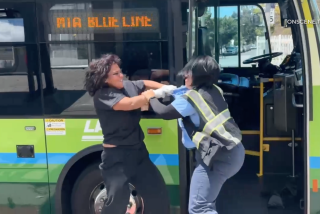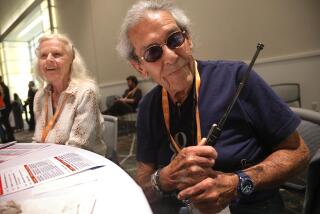Trouble lurks for women traveling alone. Here’s how to sidestep danger

- Share via
“You’ll be in Room 702, Miss Hamm, ” the hotel desk clerk said. “The elevators are right over there.”
He might as well have used the public address system to announce, “Got evil on your mind? Woman traveling alone in 702.”
You don’t encounter that kind of thoughtless endangerment much anymore. But solo women travelers face a new set of threats to safety, given the changes in the infrastructure of travel, including ride sharing and Airbnb. The sharing economy isn’t new, but the problems it poses are variations on old issues.
Airbnb and Uber have recently been in the news because of the slayings of women who used those services: Carla Stefaniak of Miami, whose body was found in December on the property of her Airbnb in Costa Rica, and Samantha Josephson, a New Jersey woman attending the University of South Carolina in Columbia, who was killed March 29 after getting into what she thought was her Uber ride. Arrests have been made in both cases.
Security and intelligence experts I spoke with emphasized that their advice is meant for everyone but may be of particular interest to women, especially those who travel alone for business or pleasure.
Focusing on women may strike some as feeding a stereotype. Statistically, women are less likely to be murdered — 78% of those killed in 2017 were men, according to the FBI Uniform Crime Report.
But other statistics send the pendulum the other way; those FBI crime stats show a 4% increase in rape from 2016 to 2017. The National Sexual Violence Resource Center notes that 91% of rape victims are women and that one in five women will be raped.
It’s “100% easier to be a man” traveling than a woman, said Bruce McIndoe, president and founder of WorldAware, a global risk management provider for companies.
Women are treated differently, he said, and are often the object of unwanted attention. “I have female colleagues who won’t go to a hotel restaurant,” he said, “They say, ‘I’m tired of being approached’ so they just stay in the room and eat dinner.”
The tips will work for anyone of any age. With help from McIndoe and his colleague, Katherine Harmon, the senior director of category intelligence; Kevin Coffey, a retired L.A. Police Department detective who speaks on travel and risk; and Matthew Bradley, regional security director Americas, International SOS and Control Risks.
Accommodations
►Whether it’s an Airbnb or a hotel, choose a place that has plenty of reviews (track record is important) and positive postings. Are some of those fake? Maybe, but it’s hard to fabricate hundreds of reviews.
►Figure out its location using Google maps (satellite) and see what’s around it. Avoid accommodations that are in the middle of nowhere, but even in a city try to divine whether the neighborhood is sketchy.
►Supplement that information with a crime mapping program such as Crimemapping.com or CrimeReports.com if you’re in the U.S., Coffey said.
►As a last check, call the police department and explain where you’re staying. Ask for a quick safety assessment of the area, said Coffey, who noted that success with this measure “depends on who picks up the phone.” But you won’t know until you ask.
►Hotels may not be your cup of tea, but most have security and may be designed to enhance that security. A big, lavish lobby may look pretty, but common sense suggests properties with a smaller footprint have a “security advantage,” Bradley said, because “it’s easier to secure a smaller space.”
►Those properties with rooms that begin on an upper floor also may provide an advantage; you generally must pass one layer of security just to get to the elevators that take you to the hotel lobby.
►When you get into an elevator with someone else, let him or her punch the floor button first. If it’s the same floor as yours, go up another level.
►Check for hidden cameras in your room. Be suspicious if there’s a smoke detector over the bed or in a corner. Coffey often turns out the lamps and looks for a pinhole of light coming from those supposed devices, a clock radio on a bedside table or even a surge protector.
Ride share
►When you summon a ride share, be sure to check the license plate and the picture of the driver on your phone — but don’t stop there. Before you get in ask, “Who are you here to pick up?” or “What’s my name?” Do this before putting anything in the trunk.
►Text someone to let him or her know that you’re taking a ride share. Explain where you are going. And text when you arrive.
►Both Uber and Lyft have a help button if your driver is driving erratically or being abusive. If your driver isn’t using the correct route (one you know or have checked out ahead of time), use the help button (remember, the ride share company is tracking your route) or call 911. Or both.
What you know — information gleaned from homework — can help.
Every time you go out, you should be as prepared, by researching ahead of time, as if you were going on an excursion, Bradley said.
Women should not stop traveling because of fear, but be prepared to take action and speak up if there’s a problem, Coffey said.
Next week: How to appear confident when you’re not and other tips for women from other women.
Have a travel problem, question or dilemma? Write to [email protected]. We regret we cannot answer every inquiry.
More to Read
Sign up for The Wild
We’ll help you find the best places to hike, bike and run, as well as the perfect silent spots for meditation and yoga.
You may occasionally receive promotional content from the Los Angeles Times.







